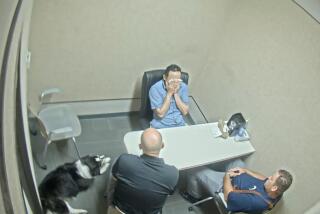Man who posed as a Rockefeller is back in court
- Share via
Jose Perez had dug into hundreds of backyards for his father’s swimming pool business, many of them in ritzy San Marino, with its tough soil of clay and rock.
One day in May 1994, he felt the shovel of his Bobcat bulldozer hit something unfamiliar. Thinking that it was perhaps decades-old trash, his father peered inside a fiberglass box and sifted through its contents, Perez recalled Wednesday in an Alhambra courtroom.
His father pulled something out and held it up with the rebar.
PHOTOS: Clark Rockefeller investigation
“It was a skull,” Perez said, chuckling as though still in disbelief at the memory.
“He thought it was a dog, but it didn’t look like a dog,” the witness said. “I told him to drop it.”
Nearly two decades after Perez and his father’s discovery, German-born Christian Gerhartsreiter appeared in court Wednesday for a hearing to determine whether there is enough evidence for him to stand trial in the 1985 death of John Sohus, whom authorities linked to the remains. Authorities say Gerhartsreiter is a con man with numerous identities who for many years pretended to be a member of the Rockefeller family and left a trail of deception from Southern California to New England.
In an indication of the man’s chameleon-like history, his defense attorneys asked Los Angeles County Superior Court Judge Jared Moses whether they may continue to refer to him as Clark Rockefeller. Attorney Brad Bailey said that was the name the attorneys of his firm, who represented Gerhartsreiter in a Boston kidnapping case, knew him by.
Moses denied the request, noting: “I honestly have never seen a circumstance where a defendant is referred to in court by one of his AKAs.”
Prosecutor Habib Balian told the judge there may be witnesses who knew Gerhartsreiter by various names from different periods of his life and may refer to him by those names.
The man, whose aliases included Christopher Chichester, Christopher Crowe and Chip Smith, came to the attention of authorities after he kidnapped his 7-year-old daughter in 2008. He was convicted in Massachusetts in that case and was extradited to California while serving a four- to five-year prison term.
The remains discovered by Perez, forensic scientists testified on Wednesday, were meticulously wrapped body parts of a man who had been bludgeoned at least three times in the head by a heavy object.
A skull, hands, feet, legs inside a pair of jeans, and a torso inside a T-shirt were found individually wrapped in plastic, testified Judith Daye, a physical anthropologist who worked for the L.A. County coroner’s office at the time of the skeleton’s discovery and responded to the scene.
“Did it appear to you someone had made a considerable effort to wrap the entire body in plastic?” Balian asked.
“Yes. There didn’t seem to be any exceptions,” Daye responded.
Forensic pathologist Frank Sheridan said that fractures to the skull indicated the victim had suffered blows to the head with a heavy, blunt object shortly before his death.
“The individual was alive when these fractures occurred and died very shortly afterwards,” said Sheridan, chief medical examiner for the San Bernardino County sheriff-coroner’s office. “There’s a lot of force involved in these blows.”
Identifying the remains discovered by Perez, authorities have said, was complicated by the fact that Sohus was the adopted son of Gerhartsreiter’s one-time landlady, Ruth “Didi” Sohus.
Prosecutors on Wednesday called to the stand a half-sister of Sohus’ who said that she hadn’t known of Sohus’ existence.
Lori Moltz, 55, said in brief testimony that a sheriff’s deputy came to her home in late 2008 to take a swab from the inside of her mouth. She also testified that she recognized her mother’s handwriting on John Sohus’ birth and adoption records.
PHOTOS: Clark Rockefeller investigation
At the end of Wednesday’s proceedings, the attorneys stipulated that DNA from Moltz and genetic materials from the skull were sent to a military lab for comparison. According to that analysis, the skull is 149 times more likely to be from a relative of Moltz than a relative of a member of the general public.
More to Read
Sign up for Essential California
The most important California stories and recommendations in your inbox every morning.
You may occasionally receive promotional content from the Los Angeles Times.











